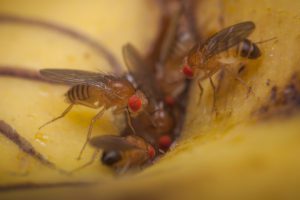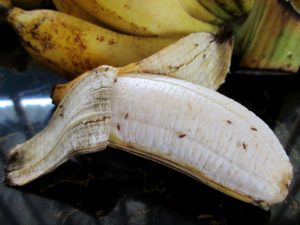‘TIS THE SEASON FOR FRUIT AND FRUIT FLIES!
By Chris Williams on September 3, 2019.
All of a sudden, our home seems to be filled with tiny flies that are getting into everything! They keep trying to crawl into drink glasses when you’re sitting in front of the TV. They hang out mostly in the kitchen though. We’ve let off a couple of bug bombs in the kitchen but by the next day or so, there are more flies. Any idea what they are and where they came from?
L.W., North Andover, MA
Ack! The dreaded small fly questions. The trouble is that there are so many possibilities; your pests could be any one of several little annoying flies, or gnats if you prefer, that can breed indoors in moist, decaying materials. The options are fungus gnats, phorid or humpbacked flies, fruit flies, and moth or drain flies. You really need to have a pest control professional on site to identify the pest and locate its breeding sources before you can expect to control it.
BRING IN LOCAL PRODUCE…BRING IN LOCAL FLIES!

Fruitflies on a banana. Shutterstock.
It’s fall or harvest season, the one time of the year in the Northeast when there is probably more ripe produce in local homes than at any other time of the year. That’s why I’m going to go out on a limb and guess that your flies are probably the very common drosophila fruit flies that we all host at one time or another. Whether the apples, peaches, melons, and tomatoes came from your own garden or from the farmers’ market, they are much more likely to arrive with fruit fly larvae or eggs already in place. Local produce has not been treated or handled in the same manner as produce from the grocery store. Once the produce is stored in your home or garage, larvae can continue their development inside the produce if it’s not refrigerated, and adult flies that are present can lay eggs in overripe produce, providing a steady supply of flies.
You can find information on fruit flies and other small indoor “gunk” flies here:
- The Pests May Not Be Fruit Flies
- Nuisance Gnats Indoors in the Fall?
- Fall Fruit Fly Problems
- Other Sources for Fruit Flies Besides Fruit
FRUIT FLIES DO NOT LIVE BY FRUIT ALONE
A fruit fly infestation can continue in your home into late fall or winter, long after your family has devoured all of the fresh fruit and vegetables. Fruit flies simply find a new breeding site, or two. The flies lay their eggs in semiliquid fermenting materials and are attracted to yeasty or vinegary odors such as those given off by wine, beer, cider, pickles, or ketchup (that’s why they hover around your glass of wine at night). In the absence of fruits or vegetables, even the liquid spills in the bottom of a garbage can or recycling bin can become a fruit fly breeding ground.

Fruit flies on a ripe banana. Shutterstock.
In a home, fruit flies can also be found in mop buckets, floor drains, drip pans, garbage disposals, and similar sites with semi-liquid organic material. They can even infest scummy drains in the same way as drain flies. A tomato that has rolled under the refrigerator and is slowly rotting can produce dozens of fruit flies before it is discovered. By the way, here’s what the maggots look like: ¼-inch long, naked white, legless, and eyeless, similar to house fly maggots but much smaller.
END THE FRUSTRATION – HIRE A PRO!
Don’t bother with the insecticide bug bombs. You may kill some of the adult flies that are out and about, but more are hidden in cracks and the developing larvae may be well protected inside a piece of produce. You’ll see new flies after you treat as fruit fly maggots pupate and emerge as adult flies.
The only way to end your fly infestation, whether fruit flies or others, is to find and eliminate the breeding sites where the maggots develop. For that, you can certainly use the skills, knowledge, and experience of a Colonial Pest technician. And our work is guaranteed! Give us a call.